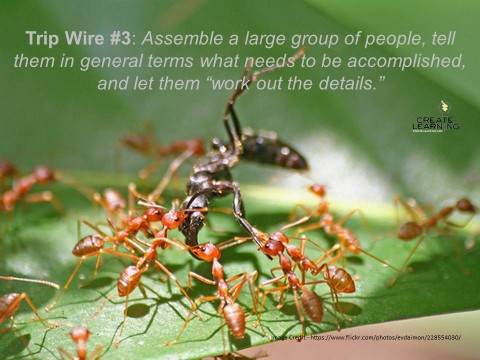
In an earlier post I share ‘5 Trip Wires in Designing and Leading Teams‘
This post looks at:
Trip Wire #3: Assemble a large group of people, tell them in general terms what needs to be done, and let them work out the details.
There is no right way to create and sustain a team.
Most team designs have been constrained by structures that have been built up over years to monitor and control employee behavior. This legacy of team design tends to viewed as a constraining, unnecessary bureaucracy to the team getting its work done. Some managers may attempt to empower the team by moving all the authority (and accountability) to them, some attempt to remove all dysfunctional features by removing any check-points or procedures that may impede the team. The hope is that by removing structure the team members will work together more creatively and effectively.
When this view is practiced, unfortunately;
- team tasks get defined in vague general terms,
- group composition is overly ambiguous,
- the limits of the team authority are kept fuzzy…
The expectation is that the “the people are smart and the team will work out the details.” The assumption is that the team will evolve or discover the structure and support that the team needs.
It doesn’t work … the team rarely evolves or discovers the needed structure. Most teams will default to manipulation, politics, bullying or apathetic behaviors.
In the absence of context for the team to operate, people will fill the absence with what they think is right. Unfortunately the loudest or most aggressive become louder and the quiet or calm just leave.
A structure that will enable team performance has 3 components:
- A well-designed team task that engages and sustains member motivation.
- A well composed team; one that is as small as possible.
- Clear and explicit specification of the boundaries of the team’s authority and accountability.
The question about team structure is not how much structure does the team have? All teams need structural supports. The question is what kind of structure? Does is it enable cooperative work, or does it make teamwork more difficult and frustrating?

